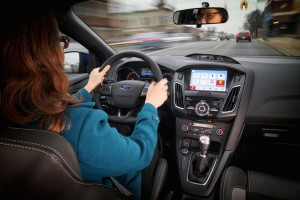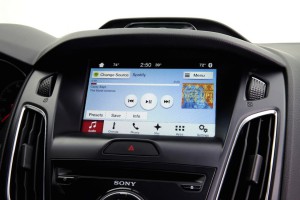
Ford introduced Sync 3 today. The new infotainment system is supposed to look and act like a smartphone.
Ford Motor Co. has completely redesigned its popular – if oft-criticized – Sync infotainment system, hoping to resolve ongoing problems while expanding the range of features and improving the system’s usability.
During a demonstration at the maker’s suburban Detroit product development center, Ford officials noted that, among other things, the new version of Sync will directly link up with Apple’s voice-activated Siri assistant, while accessing more than 40 cellphone-based apps. Behind the new capacitive touchscreen display, Sync now uses a faster microprocessor – and software developed in partnership with Panasonic, Ford abandoning its earlier alliance with tech giant Microsoft.
“We tried to make it look and act more like a smartphone,” explained Ford’s Global Product Development Director Raj Nair.
Debuting in 2007 – shortly before the first iPhone came to market – Sync made a major splash in both the automotive and high-tech worlds. It wasn’t the first technology to go by the new term, “infotainment,” but took a significant leap forward over earlier systems, such as BMW’s iDrive.
That said, Sync has come in for some widespread criticism in terms of usability and reliability – as have virtually all of the many competitive systems that have cropped up in recent years. According to both J.D. Power and Associates and Consumer Reports, infotainment technology has quickly become the single largest source of complaints about today’s new vehicles.
But such systems are also a major draw for makers like Ford, the Detroit maker claiming 43% of its buyers have said Sync was a key purchase factor for its vehicles. It hopes to see that number grow even higher in the years ahead as it expands the range of features and resolves nagging complaints.
By adopting a more smartphone-like interface, Ford and Panasonic developers are betting Sync 3’s touch and voice-based controls will be more immediately intuitive. Among other things, they have reduced the amount of text on screen, increased the use of familiar icons, and made it possible to do such things as pinch and swipe, say, to zoom in or out on a navigation screen.
A critical goal was to reduce the number of layers a user would have to access to do such things as find a local restaurant. And, again borrowing from smartphone and web practices, a motorist can now enter all necessary information in a single box – such as a complete address. There’s also a more advanced, predictive capability so, if entering the letters “ST,” Sync 3 might know the driver wants to navigate to a nearby Starbucks.
The new touchscreen migrates from an old resistive system to a faster and more responsive capacitive LCD display. The system is powered by the latest Texas Instruments processor.
(Ford grabs three slots for North American Car and Truck of the Year. For more, Click Here.)
The basic, underlying operating system for Sync 3 comes from QNX, the struggling Canadian firm that is best known for its Blackberry phone. Panasonic is overseeing software integration and the production of Sync hardware. The decision to walk away from its long partnership with Microsoft came as a surprise, but Ford insiders say the Seattle company simply wasn’t working fast enough to resolve Sync’s problems. Panasonic is hoping to enhance its reputation by making Sync once again an industry benchmark.
Ford also hopes to take the lead in terms of integrating smartphone apps, such as Pandora and Spotify, so Sync users can customize their experience, much as they have their smartphones. The automaker recently purchased a Michigan-based firm, Livio, that was working to simplify the process of pairing smartphone apps and in-car infotainment systems.
(Click Here for details about the safety technologies drivers want in their vehicles.)
Ford claims it already can access 40 different apps with the outgoing generation of Sync, and hopes to have “many, many more,” said Nair, by the time Sync 3 launches next year.
Meanwhile, Ford also plans to integrate a new WiFi receiver into cars equipped with Sync 3. It will be able to tap into a home or office network while parked in a driveway or garage and will check “several times a month,” said the Ford product chief, to see if there are updates for the system.
(To see why trucks and SUVs are dominating sales of $50k-plus vehicles, Click Here.)
Ford actually lags behind such competitors as Chevrolet and Audi in that it does not yet offer a built-in 4G LTE communications system. That could come in the near future, Don Butler, the head of Ford’s Connectivity operations told TheDetroitBureau.com.
Ford plans to introduce the new Sync 3 with the launch of its 2016 models in the U.S. market. It will then begin to switch over the technology on products sold in other parts of the world.
Along with the modified screen interface, buyers will also notice that the once-familiar MyFordTouch name will be going away, Ford planning to brand its revised infotainment system with the simple Sync 3.

